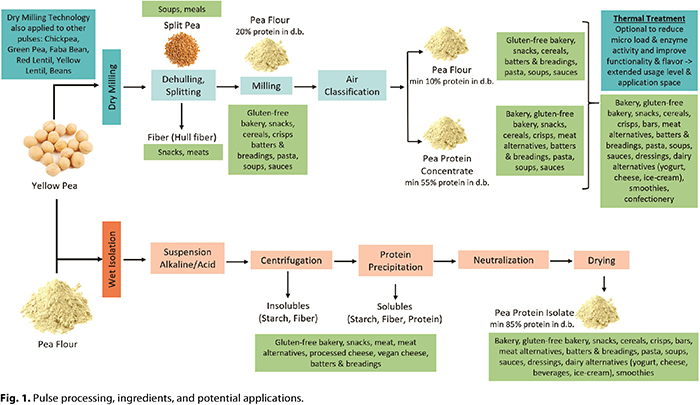Pulse Ingredients
Pulses are part of the legume family, which contains dry edible seeds of plants, including peas, lentils, beans, and chickpeas. Pulses are not genetically modified, are gluten-free, and are high in protein, dietary fiber, and micronutrients. Pulses contain 16–30% protein, 1–6.5% fat, 50–60% carbohydrates, and 5–30% fiber depending on their type and variety (1,5). For example, chickpeas are higher in fat (4.5–6%) compared with pulses such as peas, beans, and lentil, which contain 1–3% fat (1,5). Pulses are environmentally sustainable crops due to their ability to create nutrient-rich soil by fixing nitrogen in the soil. In addition, they use less water during production compared with animal-based proteins (2).
Environmentally sustainable and nutritionally balanced pulses fit within today’s top consumer trends. As a result, they are being widely used in recent food product launches.
There is tremendous innovation underway in pulse breeding, processing, and ingredient and product development to successfully utilize pulse ingredients in food formulations. Pulse ingredients derived from peas, beans, lentils, or chickpeas are available as concentrates with a minimum of 50–60% protein (db) or flours with a minimum of 10–25% protein (db). Pulse concentrates and flours are produced through dry-milling and air-classification processes. They can be further processed using heat (extrusion or steam) and moisture cooking to minimize “beanny” and “green” flavors, reduce enzyme activity and microbial count, and increase functionality. In addition to dry milling, wet-isolation (acid or salt precipitation of proteins followed by neutralization) is being used to produce pulse protein isolates that contain a minimum of 85% protein (db). Currently, pea protein isolate is the most common isolate available in the market, although additional pulse protein isolates from chickpeas and faba beans are being developed.
Pulse ingredients provide viscosity, water-holding ability, gelation, emulsification, foaming, adhesion, and film formation. Pulse proteins form weak, heat-induced gels compared with soybean and whey proteins. They can be utilized in different types of product formulations to enhance protein content and replace other proteins (e.g., soybean, gluten, dairy, meat).
During the-wet isolation process, pea starch and fiber are also produced. Pea fiber produced during wet-isolation is an inner fiber with excellent water-holding ability and can be used in meat applications. Hull fiber is also produced through dry-milling processes. It has a lower water-holding capacity compared with inner fiber and can be utilized in snack applications to control expansion. Pea starch produced through wet-isolation has excellent film-forming properties and provides a very strong gel. A brief summary of pulse processing, ingredients, and potential applications is shown in Figure 1.
Holistic Formulation Approaches with Pulse Ingredients
Bakery and Snack Applications. In bakery, baked snack, and pasta applications, pulse ingredients could be utilized to enhance protein content and replace wheat flours in gluten-free formulations. For example, pulse protein concentrates can be used successfully in bakery formulations to enhance protein content and replace up to 20% of wheat flour in a formula. It is recommended that the sponge-dough method be used to improve the volume, texture, and flavor of bread containing pulse protein concentrates and flours. A study conducted by Sozer et al. (4) showed that prefermentation of faba bean flour improved the nutritional properties of high-protein, gluten-free faba bean bread without significantly affecting its crumb structure. Incorporation of pulse proteins in bakery formulations results in darker crust color formation due to the higher lysine content of pulse proteins.
Pulse flours provide excellent synergy with other gluten-free flours, including rice, tapioca, and corn. Gluten-free tortillas, pizza crusts, and crackers are some of the key applications in which pulse flours can be used successfully to enhance texture, improve mouthfeel, provide moisture, and improve color. In these formulations, pulse flours can be used at up to 50% of the total flour. In gluten-free cracker formulations, pulse flours can be used in combination with rice and tapioca flours to balance softness, reduce or replace egg-white proteins and provide structure, and improve surface color. In addition, it is recommended that heat-treated or precooked flours be used to improve sheetability and minimize the stickiness of cracker dough. This also enables increased usage levels without impacting overall flavor profile, while minimizing green and beanny flavors. Similarly, in gluten-free tortilla formulations, pulse flours can be used to provide a soft texture, flexibility, and surface color. In gluten-free bakery formulations, gums and pregelatinized starches are often used along with pulse ingredients to improve dough handling, dough stability, and shelf life.
Pulse flours and concentrates can be used successfully in extruded snacks and cereal applications as well. In extruded snack and cereal applications, pulse flours control expansion due to their high amylose content, and they can be used at up to 100% of the total flour both in pellets and direct-extruded snacks and cereals. Additionally, pulse protein isolates, concentrates, and flours can be extruded to make crisps that can be utilized in bar applications.
Pulse proteins can be used at up to 20% in pasta formulations to enhance protein content. In gluten-free pasta formulations, chickpea, lentil, faba bean, and pea flours can be used as a base flour or combined with other gluten-free flours to create a gluten-free pasta with improved texture, appearance, and color. The use of heat-treated or precooked pulse flours aids in dough formation and results in an improved overall flavor profile with reduced green and beanny flavors. In addition, it is possible to reduce the use of gums or pregelatinized starches that are used to improve dough formation in the absence of gluten.
Batter and Breading Applications. In gluten-free batter and breading formulations, pulse flours provide even coverage with improved adhesion, good appearance, and light crispy texture. Furthermore, protein content in batter and breading formulations could be increased with use of pulse proteins. Pulse ingredients could also be used in savory applications, including soups and sauces, to enhance protein content. Formulating confectionery spreads with pulse proteins is feasible as well and could enhance protein content while enabling dairy- and nut-free formulations. In confectionery formulations in which no kill step is applied during the process, it is critical to use heat-treated or precooked pulse protein concentrates or isolates to ensure microbial safety and stability (6).
Dairy Alternatives. Formulating dairy-alternative products with pulse proteins creates several challenges for product developers. Some of these challenges are limited hydration, solubility, emulsification, and gelation of pulse proteins compared with casein proteins. In addition, processing steps may need to be adjusted to prevent excessive denaturation of plant proteins, which leads to grittiness and chalkiness in the finished product. Other challenges that product developers face when formulating with pulse proteins include texture and visual stability of the product over its shelf life, matching protein quantity, green and beanny flavors, and undesirable aftertaste. Holistic formulation approaches need to be implemented to overcome these challenges and are briefly described below.
In dairy-alternative, ready-to-drink beverages, it is recommended that pulse protein isolates be used due to their high protein content and low viscosity. Pea protein isolate with 85% protein (db) can be used successfully in these applications at up to 8% in the formula, providing nearly 15 g of protein/8 oz serving. If any protein claims will be made, the protein digestibility corrected amino acid score (PDCAAS) value of the pea protein should be considered. For example, with a PDCAAS value of 0.65 for pea protein, 10 g of protein/8 oz serving, corresponding to 20% of daily value (DV), can be delivered.
In a beverage application, it is critical to suspend the pea protein, emulsify the system, and prevent sedimentation through use of the correct hydrocolloid systems to provide a liquid gel network with minimum viscosity. Gum acacia, gellan gum, and locust bean gum at 0.2–0.4% are generally used to create a stable pea protein-based, dairy-alternative beverage.
In any dairy-alternative applications, hydrocolloids and pea protein should be hydrated before processing to properly functionalize them. It is very critical to adjust process conditions to minimize fouling and excessive protein denaturation, causing grittiness and chalkiness in the finished product. Additionally, flavor modifiers and maskers can be used to improve overall flavor and mask beanny and green flavors and undesirable aftertaste.
In dairy-alternative yogurt applications, pea protein isolates and heat-treated or precooked pulse protein concentrates can be used. In yogurt applications, hydrocolloids and/or starches also are used to provide additional texture and mouthfeel, including creaminess, and prevent syneresis.
Protein isolates and heat-treated or precooked pulse protein concentrates and flours can also be utilized in dairy-alternative cheese applications. In dairy-alternative cheese applications, pulse proteins provide emulsification, gelling, and viscosity. However, use of pulse proteins alone cannot deliver the functionality provided by casein protein, including meltability, shredability, and stretchability. Therefore, pregelatinized starches are used to enhance upfront viscosity and gel formation, and gums are used to provide elasticity and gel formation.
Meat Alternatives. Recently, there has been increased demand for meat-alternative products. There are several processing, formulation, and texture challenges facing meat-alternative product developers as well. Some of these challenges include limited juiciness, soft texture, chalky and powdery mouthfeel, and beanny and green flavors. Historically, soybean flours and concentrates and wheat gluten protein have been used in these applications (3). Today, pulse concentrates and isolates can be used successfully to produce texturized vegetable proteins (TVP) or high-moisture meat analogues (HMMA), which are the structural foundation of any meat-alternative product.
Pulse proteins are globular proteins, and through the extrusion process, they are denatured, aligned, and crosslinked to produce TVP or HMMA—meat-like fibrous structures. In meat-alternative patty processing, TVP is hydrated and then mixed with starches and gums, mainly methyl cellulose, to provide additional structure and gelling. In these applications, the use of a suitable fat system is critical to provide mouthfeel, juiciness, and flavor release. Use of flavorants, flavor maskers, and flavor modifiers in meat-analog products is recommended as well. HMMA can be used to create whole muscle products or patties and emulsified products, without the need for a hydration step.
Summary
Pulse ingredients provide nutritional and functional benefits in food formulations while meeting consumers’ demands for the creation of environmentally sustainable and nutritious products. Understanding the application needs and pulse protein functionality and developing holistic formulation approaches allow product developers to successfully formulate with pulse ingredients. There are still innovation opportunities from farm to table to further improve nutrition, flavor, and product performance.
 Dilek Uzunalioglu, Ph.D., is head of food applications at Motif FoodWorks Inc., leading food application development for Motif’s ingredient portfolio designed to improve taste, texture, and nutrition of plant-based foods. Prior to joining Motif, Dilek led the Ingredion Global Bakery & Snack Application team, as well as the Global Plant Protein application team, developing application capabilities and new ingredients, including snack texturizers, gluten-free flour systems, fibers, pulse flours, and proteins. Dilek is a graduate of the Ph.D. in Food Science program at Rutgers University. She also holds B.S. and M.S. degrees in food engineering from the Middle East Technical University. She has served as chair of the Cereals & Grain Association Carbohydrate Division and Engineering & Processing Division. Currently, she is chair of the Book Acquisitions Committee. She has published several journal articles, conference papers, and two book chapters.
Dilek Uzunalioglu, Ph.D., is head of food applications at Motif FoodWorks Inc., leading food application development for Motif’s ingredient portfolio designed to improve taste, texture, and nutrition of plant-based foods. Prior to joining Motif, Dilek led the Ingredion Global Bakery & Snack Application team, as well as the Global Plant Protein application team, developing application capabilities and new ingredients, including snack texturizers, gluten-free flour systems, fibers, pulse flours, and proteins. Dilek is a graduate of the Ph.D. in Food Science program at Rutgers University. She also holds B.S. and M.S. degrees in food engineering from the Middle East Technical University. She has served as chair of the Cereals & Grain Association Carbohydrate Division and Engineering & Processing Division. Currently, she is chair of the Book Acquisitions Committee. She has published several journal articles, conference papers, and two book chapters.
